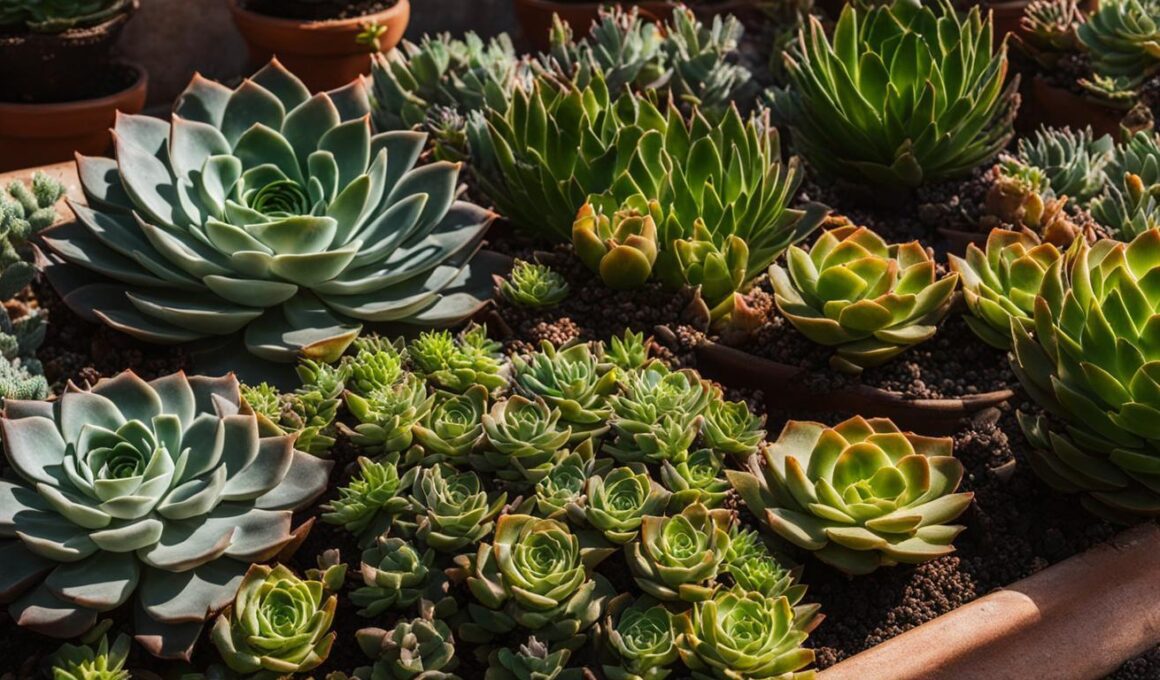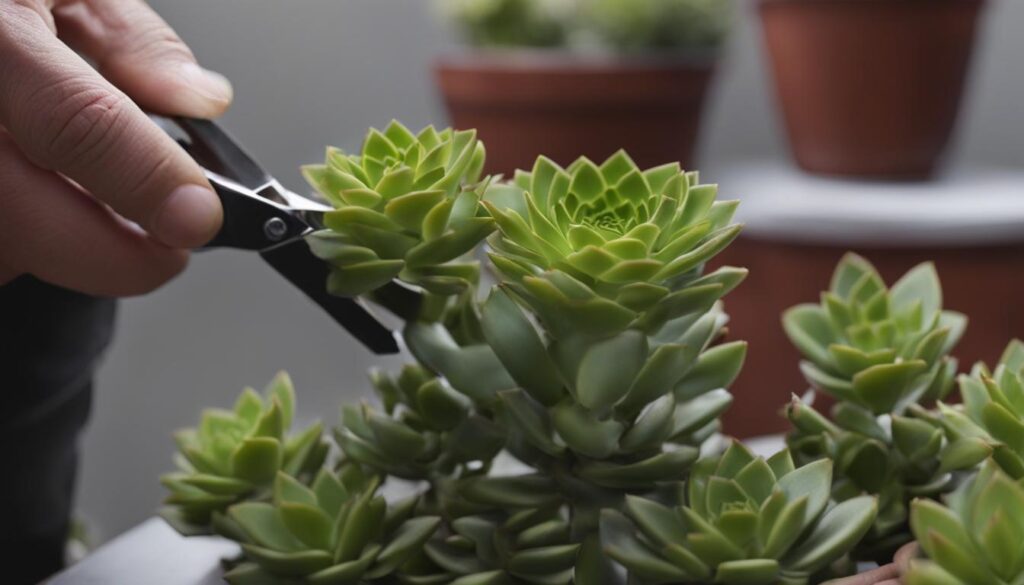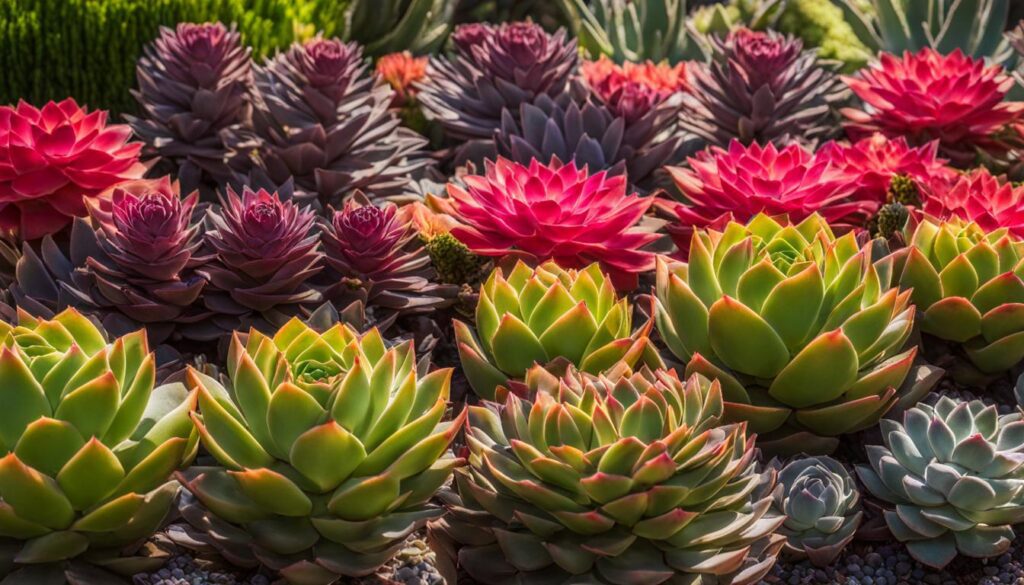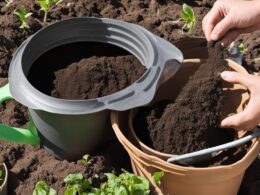As a gardener, it’s essential to know how to care for your Aeoniums after they bloom, as most varieties are monocarpic and can die after flowering. To prevent the death of the Aeonium, the flower should be trimmed before it withers on its own. Enjoying the yellow flowers is possible before cutting them off, as they attract beneficial pollinators such as bees, hummingbirds, and butterflies. Removing the expended blooms can encourage the plant to produce new baby clusters, though patience is needed as this can take weeks to months. After the bloom is trimmed, adequate sunlight and proper watering with well-draining soil promote the growth of new clusters. Avoid fixating on the remaining stump, as it will be replaced by new growth in time.
Key Takeaways
- Aeoniums are monocarpic plants that may die after flowering, requiring careful maintenance.
- Trimming the flower after it has bloomed can prevent the death of the entire plant.
- Providing adequate sunlight and well-draining soil promotes new cluster growth in place of the trimmed bloom.
- While most Aeonium varieties are monocarpic, some non-monocarpic types exist with distinct blooming patterns.
- Propagation techniques like stem cuttings can multiply the plant and extend its presence in your garden.
Understanding Aeoniums’ Monocarpic Nature and Blooming Cycle
As flowering succulents, Aeoniums display a fascinating growth pattern known as monocarpic behavior. This term refers to plants that typically die after flowering, which is observed in many Aeoniums. However, this doesn’t mean the entire plant perishes – only the mother plant is affected, and the timing of cutting the bloom significantly impacts the survival of the surrounding plant
Aeonium flowers generally emerge in late fall, persist throughout the winter months, and come to an end by springtime. Understanding the Aeonium blooming cycle is essential, as it enables gardeners to recognize when a flower is ready to be cut, ensuring the longevity of the surrounding plant, which will continue to grow and thrive with proper care.
Let’s examine the life cycle of Aeoniums more closely:
- Establishment of a healthy rosette.
- Growth of a flower stalk from the center of the rosette.
- Formation of flowers on the stalk, showing colors from soft pink to bright yellow.
- The flowering stage, attracting pollinators and adding a burst of color to the garden.
- Withering of the flowers and the mother plant’s eventual death.
- Survival and growth of offsets (baby plants) around the base of the mother plant.
Recognizing the different stages of the life cycle and the unique characteristics of Aeonium flowers is an essential aspect of providing proper care for these succulents. By understanding monocarpic behavior, you’ll be better equipped to cater to your Aeonium’s needs and help it thrive even after the blooming period.
Tips for Timely Trimming: When to Cut Aeonium Flowers
To prolong the lifecycle of a monocarpic Aeonium, it is crucial to follow proper post-bloom care. One of the most helpful practices is to cut off the flower after it has bloomed but before it naturally dies. This action not only averts the death of the entire plant but also allows for the development of new plant clusters. In this section, we will dive into the signs that indicate when it is time to trim the Aeonium’s bloom and how trimming can help in prolonging the succulent’s life.
Prolonging Your Aeonium’s Lifecycle
By trimming Aeonium flowers at the right time, you can ensure the healthy growth of new clusters and prolong the succulent’s life. To achieve this, it is essential to execute the process with precision and in a timely manner. First, allow yourself to enjoy the beautiful blooms and observe the pollinator activity. Following that, it is important to take prompt action in removing the completed bloom stalk.
Signs That It’s Time to Trim the Bloom
- Fading colors: When the vibrant colors of the Aeonium bloom start to fade, it is a clear sign that the bloom cycle is nearing its end.
- Dried petals: As the flower’s lifecycle comes to a close, the petals will begin to dry out, indicating that it is time to take action by trimming the stalk.
- Decreased pollinator activity: This could be a sign that the bloom is no longer as alluring to bees, hummingbirds, and butterflies, suggesting it is the right moment for pruning.
Remember that there is no immediate rush to trim the Aeonium’s bloom after it appears. It is essential to enjoy the flower, observe the pollinator activity, and remove the stalk only when its life cycle is complete. This will lead to the eventual growth of baby clusters from the remaining stump, contributing to a flourishing garden full of succulents.
The Beauty and Benefits of Aeonium Blooms
Among flowering succulents, Aeonium blossoms stand out not only for their vibrant yellow colors but also for the aesthetic benefits they bring to any garden. Their unique flowering process offers a fascinating transformation from a rosette foliage head to a bountiful bloom that resembles a “flowering flower.”
These monocarpic blooms bring more to the table than just their beauty. They also provide considerable benefits by attracting pollinators. These visits from bees, butterflies, and hummingbirds help support a healthy ecosystem in your garden.
Three key benefits of Aeonium blossoms include:
- Enhancing your garden’s visual appeal with their stunning, yellow flowers
- Attracting beneficial pollinators, thereby promoting a thriving ecosystem
- Offering a unique opportunity to observe the fascinating life cycle of a monocarpic succulent
When properly cared for, Aeoniums can provide many years of enjoyment, despite their monocarpic nature. By understanding when and how to trim the blooms and care for the plants, you’ll ensure these gorgeous succulents continue to grace your garden with their presence.
What to Expect: Post-Flower Care and Maintenance
Once your Aeonium has gone through its blooming process, the next crucial step is to focus on post-flowering care. With proper care, your Aeonium plant will continue to flourish even after the flowers have been trimmed.
Continued Care for the Remaining Plant
After the blooming period, concentrate on maintaining the health of the remaining Aeonium plant. Regular watering and adhering to routine plant care will help support the growth of new Aeonium clusters in place of the cut flower stalk. Be patient, as the development of new baby clusters can take a few weeks or even months. Keep an eye on the plant during this time and continue your care regimen to ensure their growth.
- Monitor your plant for signs of new growth.
- Continue regular watering, ensuring the soil remains moist but not saturated.
- Maintain proper levels of sunlight exposure, adjusting as needed to accommodate varying seasonal conditions.
Meeting Soil and Sunlight Needs After Flowering
To help your Aeonium generate new plant clusters after the flowering period, it is crucial to provide the appropriate amount of sunlight. While succulents are known for favoring bright light, it is essential to understand the specific sunlight needs of the Aeonium to prevent scorching. Too little or too much sunlight can be detrimental to the plant’s overall health.
Additionally, using well-draining succulent soil will allow for minimal watering and foster ideal conditions for new growth. Proper soil conditions are essential components of the post-flower care regimen.
| Soil Type | Sunlight Requirements | Watering Frequency |
|---|---|---|
| Well-draining succulent soil mix | Partial to full sun (6-8 hours per day) | Water around every 7-10 days or when soil is dry |
Paying attention to soil and sunlight requirements will make a significant impact on the overall succulent health of your Aeonium. Combining these post-flowering care tips with regular plant upkeep will ensure a thriving and beautiful Aeonium plant for years to come.
Propagation: Turning Blooms into New Growth Opportunities
Aeonium propagation offers gardeners the opportunity to transform blooms into new growth opportunities and extend the life of their succulent garden. By utilizing stem cuttings, the process encourages branching and new plant growth. While cutting the bloom stalk immediately after flowering will not produce new growth, patience and continued care will reward you with the emergence of baby plants.
Aeoniums are primarily propagated via stem cuttings. Below are three simple steps for Aeonium propagation, aimed to turn blooms into new growth:
- Select a healthy stem: Choose a stem with a healthy rosette at its tip.
- Make a clean cut: Using clean, sharp gardening shears, make a straight cut through the stem, approximately 2-4 inches below the rosette.
- Prepare the cutting for planting: Remove any lower leaves to expose a section of the stem, and allow the cut end to dry for a few days, forming a callus that will protect it from rot during the rooting process.
Once the cuttings are prepared, plant them in succulent soil mix and provide proper care to encourage successful root development. The table below summarizes the optimal conditions for rooting and growing Aeonium cuttings.
| Parameter | Optimal Condition |
|---|---|
| Soil | Well-draining succulent soil mix |
| Water | Water sparingly; ensure soil is dry between waterings |
| Light | Bright, indirect light |
| Temperature | 65-75°F (18-24°C) |
| Humidity | Average room humidity |
As the Aeonium cutting takes root and begins to grow, you will witness the baby plants’ emergence, eventually forming a new, thriving succulent in your garden. Through Aeonium propagation, you can make the most out of the plant’s blooming cycle and ensure the continuous success of your succulent collection.
Identifying Non-Monocarpic Aeonium Varieties
While most Aeoniums are monocarpic, not all share this trait. Non-monocarpic Aeoniums bloom from the sides or underneath the rosettes, rather than the center. These plants display more discreet flowers and do not die post-bloom. Identifying the characteristics of these unique Aeonium varieties helps in understanding their distinct flowering patterns and post-bloom behavior, which differ from their monocarpic counterparts.
Characteristics of Non-Monocarpic Aeoniums in Bloom
Non-monocarpic Aeoniums exhibit several key traits that set them apart from their monocarpic counterparts. Some of these distinguishing features include:
- Location of the bloom: Non-monocarpic Aeoniums produce flowers from the sides or underneath the rosettes instead of the center.
- Discreet flowers: Their flowers are often smaller and less imposing compared to the vibrant blooms of monocarpic Aeoniums.
- Post-bloom survival: These Aeoniums do not die after flowering, allowing for a longer life cycle and continuous growth.
Understanding these characteristics helps in identifying and distinguishing the non-monocarpic Aeoniums from their monocarpic counterparts.
| Non-Monocarpic Aeonium | Location of the Bloom | Flower Appearance | Post-Bloom Survival |
|---|---|---|---|
| Aeonium haworthii | Side of the rosette | Small, pale yellow flowers | Yes |
| Aeonium decorum | Underneath the rosette | Subtle, pinkish-white flowers | Yes |
| Aeonium undulatum | Side of the rosette | Bright yellow, clustered flowers | Yes |
By familiarizing yourself with the distinct characteristics and identifying flower types, you can ensure proper care and maintenance of non-monocarpic Aeoniums in your garden or indoor space.
Encouraging Aeoniums to Branch Out and Flourish
One of the most effective ways to encourage Aeonium branching and promote the growth of flourishing succulents is through the use of stem cuttings. This propagation technique not only helps Aeoniums develop multiple branches from a single rosette but also contributes to the overall health of the plant. In this section, we’ll introduce the crucial steps to facilitate Aeonium branching and create a thriving environment for your succulent garden.
- Preparing the stem cutting: Carefully cut a healthy stem from the parent Aeonium, ideally from a branch with a rosette at its tip. Allow the freshly cut stem to dry for a couple of days, forming a callous over the wound. This process prevents the stem from rotting when planted.
- Applying rooting hormone (optional): While not required, dipping the cut end of the stem in rooting hormone can speed up the process of root formation and encourage successful propagation.
- Planting the stem cutting: Plant the prepared stem cutting in a well-draining soil mix, designed specifically for succulents. The appropriate soil composition enables optimal moisture retention and drainage, supporting healthy root development.
- Providing the right environment: Keep the newly planted cutting away from direct sunlight, in a spot with bright, indirect light. This environment prevents the stem from burning and allows the roots to form effectively.
- Monitoring the progress: Once the Aeonium cutting has rooted, you will notice new growth emerging from the base and sides of the stem. At this stage, you can gradually introduce the plant to more direct sunlight to encourage further branching and robust growth.
By following these succulent propagation techniques, you will help your Aeoniums to branch out and flourish, creating a vibrant and lively succulent garden with a unique aesthetic appeal.
Would Aeoniums Thrive If Planted in Rocks After Flowering?
Aeoniums may not thrive when planting succulents in rocks after flowering. While these plants are adaptable, they require well-draining soil and a suitable environment for growth. Planting in rocks may not provide the necessary nutrients and moisture retention for healthy growth, affecting the overall health of the aeoniums.
Conclusion
In conclusion, understanding the Aeonium bloom cycle and properly caring for these unique succulents after flowering ensures their continued success in your succulent garden. By learning the intricacies of Aeonium care, you can enhance your garden with their singular beauty and engaging lifecycle.
Properly timed trimming of blooms prevents monocarpic varieties from dying after flowering, allowing them to produce new baby clusters in time. Additionally, post-flower care that includes giving the plant adequate sunlight and using well-draining succulent soil promotes growth and longevity.
By acquainting yourself with both monocarpic and non-monocarpic Aeonium varieties, you enable the opportunity to create a robust succulent collection with year-round interest. These charming plants are worth your time and effort, providing numerous benefits and the chance to witness nature’s cycles firsthand.











